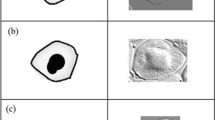Abstract
Automatic image analysis of histopathology specimens would help the early detection of blood cancer. The first step for automatic image analysis is segmentation. However, touching cells bring the difficulty for traditional segmentation algorithms. In this paper, we propose a novel algorithm which can reliably handle touching cells segmentation. Robust estimation and color active contour models are used to delineate the outer boundary. Concave points on the boundary and inner edges are automatically detected. A concave vertex graph is constructed from these points and edges. By minimizing a cost function based on morphological characteristics, we recursively calculate the optimal path in the graph to separate the touching cells. The algorithm is computationally efficient and has been tested on two large clinical dataset which contain 207 images and 3898 images respectively. Our algorithm provides better results than other studies reported in the recent literature.
Chapter PDF
Similar content being viewed by others
Keywords
- Acute Myelocytic Leukemia
- Acute Lymphocytic Leukemia
- Chronic Lymphocytic Leukemia
- Mantle Cell Lymphoma
- Automatic Image Analysis
These keywords were added by machine and not by the authors. This process is experimental and the keywords may be updated as the learning algorithm improves.
References
Rozman, C., Montserrat, E.: Chronic lymphocytic leukemia. The New England Journal of Medicine 333(16), 1052–1057 (1995)
Cotran, R., Kumar, V., Collins, T., Robbins, S.: Pathologic basis of disease, 5th edn. W.B. Saunders Company, Philadelphia (1994)
Aisenberg, A.: Coherent view of non-Hodgkin’s lymphoma. J. Clin. Oncol. 13, 2656–2675 (1995)
Moga, A.N., Gabbouj, M.: Parallel marker-based image segmentation with watershed transformation. Journal of Parallel and Distributed Computing 51(1), 27–45 (1998)
Grau, V., Mewes, A.U.J., Alcaniz, M., Kikinis, R., Warfield, S.K.: Improved watershed transform for medical image segmentation using prior information. ITMI 23(4), 447–458 (2004)
Nguyen, H.T., Ji, Q.: Improved watershed segmentation using water diffusion and local shape priors. CVPR 1, 985–992 (2006)
Scott, D.W.: Parametric statistical modeling by minimum integrated square error. Technometrics 43, 274–285 (2001)
Yang, L., Meer, P., Foran, D.: Unsupervised segmentation based on robust estimation and color active contour models. IEEE Trans. on Information Technology in Biomedicine 9, 475–486 (2005)
Wyszecki, G., Stiles, W.S.: Color Science: Concepts and Methods, Quantitative Data and Formulae, 2nd edn. Wiley, Chichester (1982)
Chetverikov, D., Szabó, Z.: A simple and efficient algorithm for detection of high curvature points in planar curves. In: The 23rd Workshop of the Austrian Pattern Recognition Group, pp. 175–184 (1999)
Stahl, J.S., Wang, S.: Convex grouping combining boundary and region information. ICCV 2, 946–953 (2005)
Elder, J.H., Goldberg, R.M.: Ecological statistics of Gestalt laws for the perceptual organization of contours. Journal of Vision 2(4), 324–353 (2002)
Adiga, P.S.U., Chaudhuri, B.B.: An efficient method based on watershed and rule-based merging for segmentation of 3D histo-pathological images. J. Pattern Recognition 34(7), 1449–1458 (2001)
Cai, W., Chung, A.C.: Multi-resolution vessel segmentation using normalized cuts in retinal images. In: Larsen, R., Nielsen, M., Sporring, J. (eds.) MICCAI 2006. LNCS, vol. 4191, pp. 928–936. Springer, Heidelberg (2006)
Author information
Authors and Affiliations
Editor information
Rights and permissions
Copyright information
© 2008 Springer-Verlag Berlin Heidelberg
About this paper
Cite this paper
Yang, L., Tuzel, O., Meer, P., Foran, D.J. (2008). Automatic Image Analysis of Histopathology Specimens Using Concave Vertex Graph. In: Metaxas, D., Axel, L., Fichtinger, G., Székely, G. (eds) Medical Image Computing and Computer-Assisted Intervention – MICCAI 2008. MICCAI 2008. Lecture Notes in Computer Science, vol 5241. Springer, Berlin, Heidelberg. https://doi.org/10.1007/978-3-540-85988-8_99
Download citation
DOI: https://doi.org/10.1007/978-3-540-85988-8_99
Publisher Name: Springer, Berlin, Heidelberg
Print ISBN: 978-3-540-85987-1
Online ISBN: 978-3-540-85988-8
eBook Packages: Computer ScienceComputer Science (R0)




